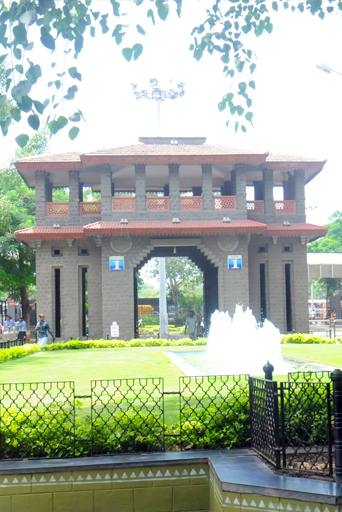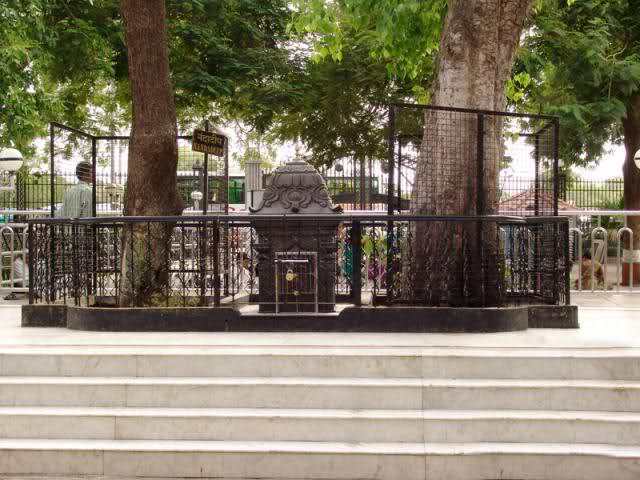Lendi Baugh/Garden
(Baba’s place of penance and paradise)
At the end of 1999, Lendi Gardens was radically relandscaped, and the previously paved and tree-lined area turned into a lawn with waterfall and flower beds. Lendi is significant as a place which Baba used to visit every day. It contains some tombs, a shrine, and most importantly the perpetually burning lamp lit by Baba and placed between the two trees he planted. A few months before Baba’s mahasamadhi the land was bought by a Bombay devotee, M. W. Pradhan, and later presented to the Sansthan.
In Baba’s time, Lendi was an area of wasteland between two small streams, the Lendi and the Sira (now dried up). Baba used this area for toilet purposes. He would leave the mosque for Lendi around nine o’ clock in the morning accompanied by some devotees. However, none was allowed inside with him except Abdul Baba.
Apart from answering the calls of nature here, Baba seemed to enjoy going to Lendi and sometimes went several times a day. This was the place where he spent time in solitude.
It was a particular characteristic of Baba’s the once he had started something, it became a strict and lifelong routine. For example, though initially devotees forced him out of the mosque into Chavadi because of severe rain, he continued the routine of sleeping there every other night as long as he was alive. Similarly, after his arm had got burnt in the dhuni, it was dressed and tended by Bhagoji Shinde. The wound healed and Baba lived for a further eight years, but the practice of Bhagoji changing the bandage every day continued until the end.
Showing a similar regard for routine, Baba always took the same route whenever we went to Lendi from Dwarkamai. A fakir will sometimes take up non-deviation from routine as a practice, as it is supposed to reduce the opportunity for personal preference, and hence development of the ego. Baba had no need for any practice, but he seemed to maintain the routine anyway. His route to Lendi was not the most direct or obvious, yet he stuck to it unswervingly. Perhaps we will never know what is reasons were, but just as Baba used to go along with a few devotees, lets us also walk with him and take a short stroll to Lendi.
We begin by turning right out of Dwarkamai, then left down a narrow lane opposite the entrance to Gurusthan. Halfway along this path, the route kinks right and immediately left. Baba would often pause at this corner (which was where his devotee Balaji Pilaji Gurav lived) and, taking up the posture of Vittal, stand facing the small Vittal temple opposite. A small shrine enclosing a pair of padukas now marks the spot where he would stand. At that time, the temple was private, but now it is publicly owned and has been reconstructed a little further down the lane on the left.
At the bottom of the lane we turn right, and within a few metres, come to a small temple on the left opposite the post office. This is one of the oldest temples in Shirdi. It is dedicated to Sri Kanifnath, one of the nine leaders of the Nath cult, whose distinguishing feature is the maintenance of a dhuni. Baba used to sometimes linger here. Perhaps he had some connection with the place and therefore incorporated it into his routine? From here we turn right along the main road and make our way to Lendi, again on the right. Now the area is peppered with small stalls selling trinkets and snacks, but in Baba’s time it would have been virtually empty. Arriving at Lendi we may pause for a moment and remember that this was where Baba asked his devotees to also wait, since he preferred to enter Lendi alone.

Nanda Deep
This is the main feature of Lendi : the perpetually-burning lamp between the two trees that Baba planted side by side, a neem and a bodhi. It is said that these trees at first remained spindly and would not grow until one day Baba shook them, and that from then on they flourished. They were touched by Baba and planted close to where he sat, serve as a focus for pradakshina along with the lamp.
Nanda Deep (“lamp of bliss”, also known as Akhanda Deep – “perpetually burning lamp”) is placed between the trees and was originally lit by Baba. Later, he instructed Abdul Baba to see that it was kept burning.
The lamp as we see it now was built by the Sansthan and the area has been paved. In Baba’s time the lamp was sunk into a small pit and protected from the wind by some zinc sheets and later some pieces of cloth, making a kind of tent with the lamp in the centre.

